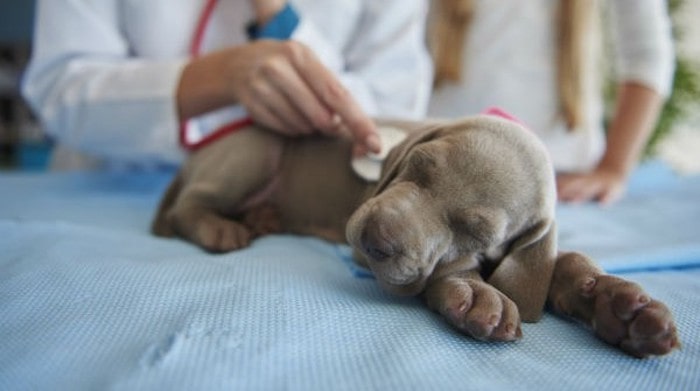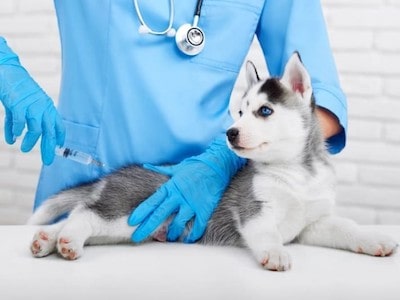As a devoted dog owner, the well-being of your furry companion is undoubtedly a top priority. However, lurking in the shadows is a highly contagious and potentially deadly virus that poses a significant risk to dogs worldwide – Canine Parvovirus, commonly known as Parvo.
This insidious disease can strike without warning, leaving devastated pet parents in its wake. In this blog article, we delve into the depths of Parvo in dogs, unraveling its mysteries, exploring its symptoms, and providing essential insights on prevention and treatment.
Join us on this informative journey to safeguard your canine friend from the clutches of Parvo and ensure a healthier, happier life for your beloved pet.
What Is Parvo and How Does It Affect Dogs?
Parvo is a DNA virus that belongs to the family Parvoviridae and the genus Protoparvovirus. It was first discovered in the 1970s and rapidly became a serious threat to canine health. There are two main strains of parvo that affect dogs: CPV-2a and CPV-2b. There is also a newer strain, CPV-2c, that has been detected in some countries. All strains of parvo can cause similar symptoms and complications in dogs.
Parvo infects the rapidly dividing cells of the intestinal tract and bone marrow of dogs. This means that it affects the ability of the dog to absorb nutrients and fight infections. Parvo can also damage the heart muscle cells of very young puppies, causing a condition called myocarditis, which can lead to heart failure.

Parvo can affect dogs of any age, breed, or vaccination status, but it is more common and severe in young and unvaccinated dogs. Puppies between six weeks and six months of age are especially vulnerable to parvo because they have not yet developed a strong immune system and may not have received adequate vaccination.
Some breeds of dogs, such as Rottweilers, Doberman Pinschers, Pit Bulls, Labrador Retrievers, German Shepherds, and English Springer Spaniels, may be more susceptible to parvo than others.
Parvo can cause symptoms such as lethargy, fever, abdominal pain, vomiting, diarrhea (often bloody), weight loss, and collapse. The symptoms usually appear within three to ten days after exposure to the virus. The vomiting and diarrhea result in dehydration that upsets the electrolyte balance and affects the dog’s vital organs.
The loss of blood and protein through the intestines leads to anemia and low blood pressure. The damage to the intestinal lining allows bacteria and toxins to enter the bloodstream, causing endotoxemia and septic shock. The low white blood cell count due to bone marrow suppression makes the dog more prone to secondary infections. The combination of these factors can lead to death in up to 91% of untreated cases.
How to Prevent Parvo in Dogs and Puppies
The best way to prevent parvo infection in dogs is through vaccination. Vaccination stimulates the immune system to produce antibodies that can fight off the virus if exposed. Vaccination is especially important for puppies, as they are more vulnerable to parvo due to their immature immune system and lack of maternal antibodies
The recommended parvo vaccine schedule for puppies is as follows:
- The first vaccine should be given at 6 to 8 weeks of age.
- The second vaccine should be given at 10 to 12 weeks of age.
- The third vaccine should be given at 14 to 16 weeks of age.
- A booster vaccine should be given at one year of age.
The recommended vaccination schedule for adult dogs is as follows:

- If the dog has never been vaccinated before or has an unknown vaccination history, it should receive two vaccines 3 to 4 weeks apart.
- If the dog has been vaccinated before and has a known vaccination history, it should receive a booster vaccine every 1 to 3 years depending on the type of vaccine used.
In addition to vaccination, owners should also take some precautions to avoid exposing their dogs to parvo, such as:
- Keeping their dogs away from unvaccinated or sick dogs, especially in public places.
- Cleaning and disinfecting any items or surfaces that may have come into contact with infected feces using diluted bleach or specialized cleaners.
- Washing their hands thoroughly after handling any dog or dog-related material.
- Consulting their veterinarian before introducing a new dog or puppy into their household.
How Is Parvo Diagnosed and Treated?
Parvo is diagnosed by testing the feces of a suspected dog for the presence of the virus or its antibodies. There are different methods that can be used for this purpose, such as enzyme-linked immunosorbent assay (ELISA), hemagglutination assay (HA), electron microscopy (EM), or polymerase chain reaction (PCR). These tests can detect the virus or its antigens (proteins) or its DNA in the fecal sample.
Parvo treatment is supportive and involves intensive veterinary care to correct dehydration, electrolyte imbalance, infection, pain, and inflammation. There is no specific antiviral drug that can cure parvo, but there are some treatments that can help the dog’s immune system fight the virus and prevent complications.
Parvo treatment may include fluids, antibiotics, antiemetics, antidiarrheals, painkillers, blood transfusions, and immunoglobulins. Fluids are given intravenously or subcutaneously to rehydrate the dog and restore the electrolyte balance. Antibiotics are given to prevent or treat secondary bacterial infections that may occur due to the damage to the intestinal lining.

Antiemetics are given to control vomiting and reduce nausea. Antidiarrheals are given to reduce the frequency and severity of diarrhea. Painkillers are given to relieve abdominal pain and discomfort. Blood transfusions are given to replace the blood loss and improve the oxygen delivery to the tissues. Immunoglobulins are given to provide passive immunity and neutralize the virus.
Parvo treatment is expensive and may require hospitalization for several days or weeks depending on the severity of the infection and the response of the dog. The dog may need to be isolated from other dogs to prevent the spread of the virus. The dog may also need to be fed a bland diet or a special prescription diet to help the intestinal tract heal and restore its function.
Parvo survival rate depends on the severity of the infection, the age of the dog, the timeliness of diagnosis and treatment, and the quality of care. With prompt diagnosis and aggressive treatment, up to 80% of dogs may survive parvo. However, some dogs may suffer from long-term complications such as chronic diarrhea, weight loss, or heart problems.
How to Care for a Dog Recovering from Parvo
A dog recovering from parvo infection will need supportive care at home to help them regain their strength and health. Owners should follow the instructions and recommendations of their veterinarian regarding medication, diet, hydration, and follow-up visits. Some general tips on how to care for a dog recovering from parvo are:

- Provide plenty of fresh water and encourage the dog to drink frequently to prevent dehydration.
- Offer small amounts of bland food several times a day to stimulate appetite and digestion. Some examples of bland food are boiled chicken, rice, cottage cheese, or baby food. Avoid giving any food that is spicy, fatty, or high in fiber.
- Add probiotics or yogurt to the food to help restore the normal flora of the intestines and improve digestion.
- Monitor the dog’s weight, temperature, pulse, respiration, and stool quality daily and report any abnormal changes to the veterinarian.
- Keep the dog in a clean, warm, and comfortable environment away from other dogs or potential sources of infection.
- Follow up with the veterinarian regularly until the dog is fully recovered and has a negative fecal test for parvo.
FAQs
While puppies are at higher risk, adult dogs can also contract Parvo, especially if they are unvaccinated or have a weakened immune system. Vaccination remains crucial for preventing Parvo in dogs of all ages.
No, Canine Parvovirus is specific to dogs and cannot infect humans. However, humans can inadvertently carry the virus on their hands or clothing, potentially spreading it to other dogs.
With prompt and appropriate treatment, many dogs can survive Parvo. However, the disease is serious and can be fatal, especially if left untreated or if the dog’s immune system is compromised.
Yes, disinfection is essential to prevent the spread of Parvo. Use a bleach solution (1 part bleach to 32 parts water) to clean all surfaces, toys, bedding, and other items that may have come into contact with the infected dog’s feces. It’s crucial to follow proper disinfection protocols to ensure effectiveness.
Generally, dogs who have recovered from Parvo develop immunity to the virus, which reduces the likelihood of re-infection. However, maintaining up-to-date vaccinations is still essential to ensure continued protection.
Conclusion
Parvo is a deadly disease that can affect any dog but is especially dangerous for puppies and unvaccinated dogs. It causes severe gastrointestinal symptoms that can lead to dehydration, shock, and death.
The best way to protect your dog from parvo is to vaccinate them regularly and avoid contact with infected dogs or environments. If you suspect your dog has parvo, seek veterinary attention immediately.
With prompt diagnosis and aggressive treatment, your dog may have a chance to recover from this devastating infection.

Ellis is a retired veterinary technician and full-time contributor at DogLovesBest. He likes writing about pet health care tips and reviews the products that are useful for fidos on a daily basis.
Ellis also guardians a Siberian husky, Nova, and a cat named Shilly. They all live happily with his wife Ammy, and both the dogs on a seaside apartment in Queens, NY.
